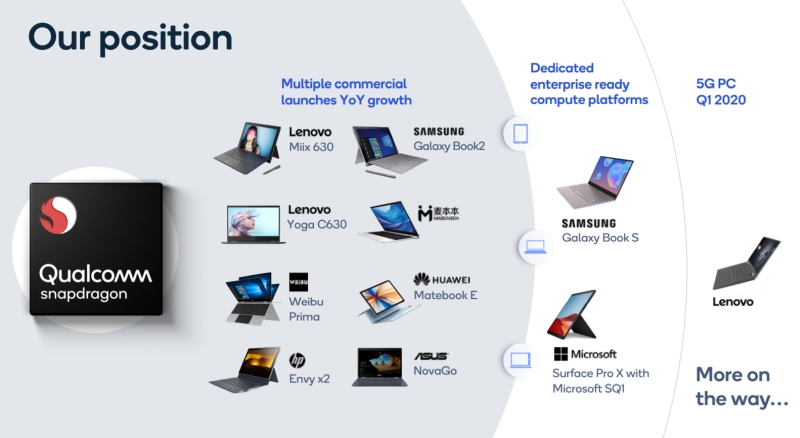During presentation led by Miguel Nunes, Senior Director of Product Management for Compute Products, Qualcomm was quite keen to note that the company is at the forefront in leading the PC industry to mobile, and was the first in many things including Gigabit LTE PC, 5G PC, multi-day battery life, 7nm PC platform, and always-on, always-connected platform, all starting with Snapdragon 835 SoC, Snapdragon 850, Snapdragon 8cx, and the Snapdragon 8cx 5G.
While previously available Snapdragon compute platform offered extreme performance and premium designs in their own segment, it was obvious that there was a need to cover other segments of the always-on, always-connected market, and that is where Snapdragon 8c and Snapdragon 7c come in.
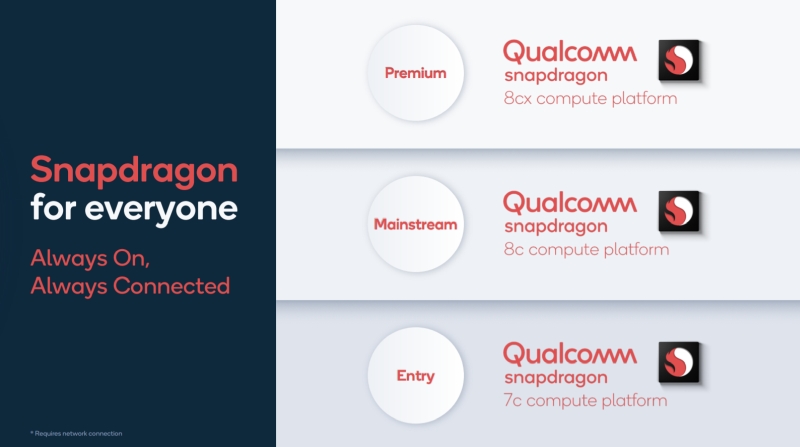
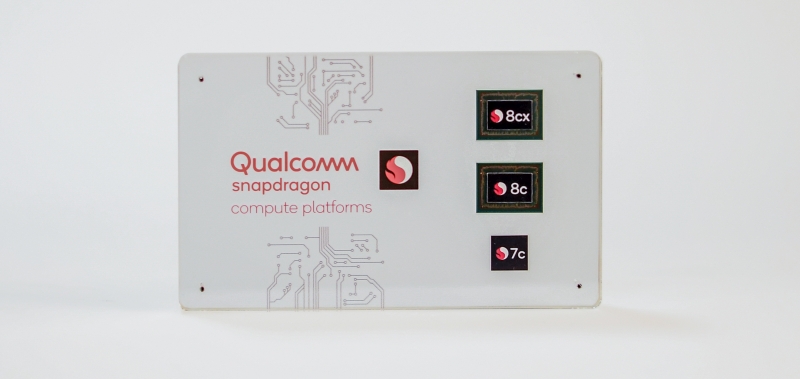
Snapdragon 8c aims to bring responsive performance and superior battery life to mainstream laptops
According to Qualcomm, the Snapdragon 8c will deliver up to 30 percent faster total system performance compared to the previously available platform, namely Snapdragon 850, offering responsive performance and superior battery life, and enabling ultra-thin, light, and fanless mainstream always-on, always-connected systems with multi-gigabit cellular connectivity.
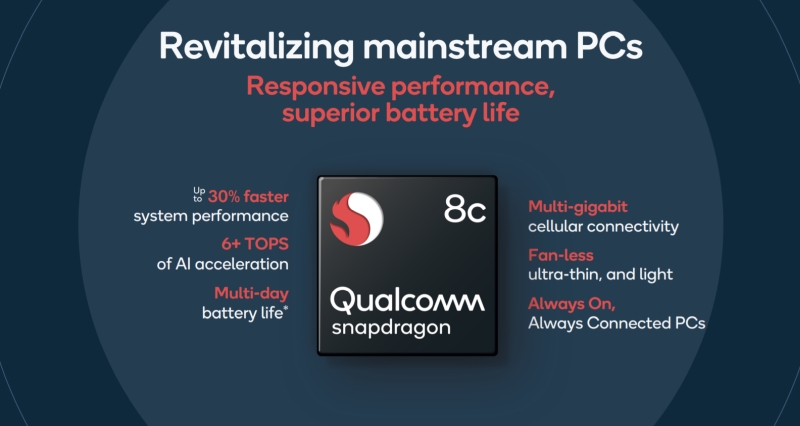
Hardware-wise, the Snapdragon 8c compute platform is a 7nm chip with octa-core CPU SoC featuring eight Kryo 490 CPU cores clocked at up to 2.45GHz and paired up with Adreno 675 GPU. It supports 2133MHz LPDDR4x memory and NVMe SSD and UFS 3.0 storage.
According to Qualcomm, the Kryo 490 CPU cores provide up to 25 percent faster single- and multi-threaded performance, while the GPU is up to 40 percent faster, all compared to the previous generation platform.
The platform also comes with Qualcomm Hexagon 690 DSP with Qualcomm All-Ways Aware technology, and 4th generation Qualcomm AI engine, offering over 6 TOPS of AI performance. Qualcomm paired up the Snapdragon 8c with Spectra 390 ISP, which is a dual 14-bit ISP that supports dual 16MP or single HFR 32MP camera.
Audio is handled through Qualcomm's Aqstic audio technology with support for Qualcomm TrueWireless, Broadcast Audio, and aptX technologies.
As far as display support goes, Snapdragon 8c supports 4K/UHD on-device display and two 4K/UHD external display support.
Connectivity-wise, the platform comes with integrated Snapdragon X24 LTE modem, with peak download (DL) of 2Gbps and peak upload (UL) of 316Mbps. The platform can be paired up with Qualcomm's latest Snapdragon X55 Modem-RF System, with mmWave, sub-6 GHz, 5G/4G spectrum sharing, standalone (SA) and non-standalone (NSA) modes, and peak DL of 7Gbps and UL of 3Gbps.
It also comes with 802.11ad dual-band WiFi with MU-MIMO (2x2) support, Bluetooth 5.0, NFC, GPS, and all other usual connectivity options, as well as Qualcomm Quick Charge 4+ technology.
Snapdragon 7c for entry-level always-on, always-connected PCs
In addition to the Snapdragon 8c that should bring mainstream laptops, 2-in-1s and other mobile PCs, Qualcomm is also aiming to bring Snapdragon compute platform experience to the masses, with the Snapdragon 7c compute platform.
According to Qualcomm, the Snapdragon 7c should provide up to 25 percent better system performance, 5+ TOPS of AI performance, and 2x the battery life, at least compared to an unnamed competing solution, most likely current Intel-equipped ultrabooks. Qualcomm also has an important ace up its sleeve, lightning-fast connectivity, thanks to its LTE and 5G modems.
With Snapdragon 7c, Qualcomm is bringing a complete System-in-Package which is operator certified, and this means faster commercialization, lower development costs, as well as thinner and smaller system boards, ultimately offering affordable always-on, always-connected systems for the masses.
Unlike the Snapdragon 8c which is a 7nm SoC, the Snapdragon 7c is manufactured on 8nm, most likely the same Samsung 8nm LPP used for some of Qualcomm's mainstream mobile SoCs.
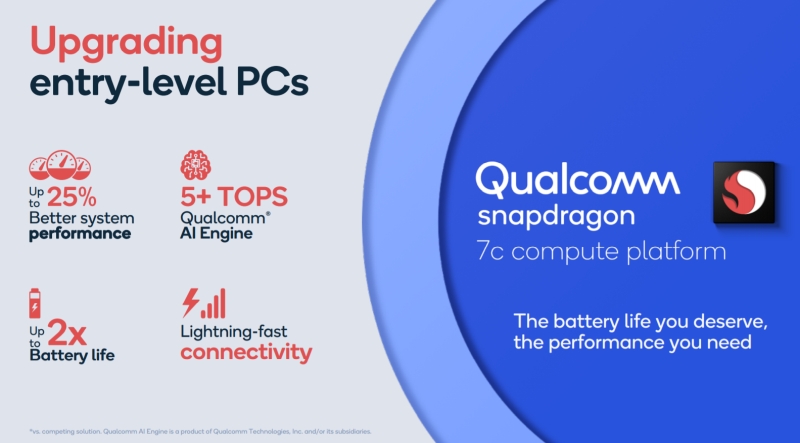
Hardware-wise, the Snapdragon 7c is also an octa-core CPU SoC, with Kryo 468 cores clocked at up to 2.4GHz, and paired up with Adreno 618 GPU. The GPU should be powerful enough to do 4K 30fps video playback with HDR support with H.264 (AVC), H.265 (HEVC) VP8 and VP9 decoding, as well as 4K 30fps video capture with H.264 (AVC) and H.265 (HEVC) encoding.
It supports LPDDR4 memory clocked at up to 2133MHz, as well as eMMC 5.1 or UFS 3.0 storage, so no support for NVMe SSDs on the mainstream platform.
The SoC also comes with Qualcomm's Hexagon 629 DSP, with 4th Generation Qualcomm AI Engine, Hexagon Vector eXtensions, and Hexagon Tensor Accelerator. As noted, this should be enough for 5+ TOPS of AI performance. Qualcomm equipped the Snapdragon 7c with Spectra 255 ISP with 14-bit ISPs and support for 4K HDR video capture at 30 FPS, and support for dual 16MP or single HFR 32MP camera, both with support for 30FPS with Zero Shutter Lag.
Audio is handled by Qualcomm Aqstic audio codec and Qualcomm Aqstic smart speaker amplifier with support for Qualcomm aptX.
The Snapdragon 7c supports FHD (2048x1536 at 60 Hz) and QXGA (2048x1536 at 60 Hz) on-device displays, as well as QHD (2560x1440 at 60Hz) external display support, so it gives you a better idea on what devices to expect, at least from the display resolution side.
Unlike the Snapdragon 8c connectivity, the entry-level Snapdragon 7c comes integrated with Qualcomm's Snapdragon X15 LTE modem with support for 800Mbps 3x20 DL and 150Mbps 2x20MHz UL LTE.
You also get Qualcomm Wi-Fi Solutions with standard (11ax) ready 2.4GHz/5GHz dual-band Wi-Fi, Bluetooth 5.1, and GPS.
Qualcomm has plenty of OEMs on-board already, more in Q1 2020
Qualcomm has been hard at work to push its always-on, always-connected platform to OEMs, staring back with the Qualcomm Snapdragon 835. ASUS, Lenovo, HP, and even Huawei, were on-board since the beginning, but recently, it got a whole lot more traction with Samsung and its Galaxy Book S and Microsoft with its premium Surface Pro X (with "custom" SQ1 SoC which is based on 8cx).
There are plenty of OEMs on-board and more will likely join soon, and offering platforms across all market segments will definitely help as it will push both those same OEMs as well as Microsoft and its Windows on ARM development to a whole new level, and it all happens in Q1 2020, so hopefully, we will hear more about these and all other devices at CES 2020 and beyond.
